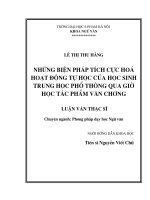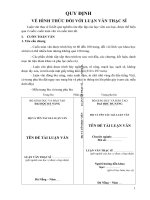(Luận văn thạc sĩ) private equity investmentframework and prospect for vietnam
Bạn đang xem bản rút gọn của tài liệu. Xem và tải ngay bản đầy đủ của tài liệu tại đây (24.24 MB, 68 trang )
V IE T N A M N A T IO N A L U N IV E R S IT Y , H A N O I
S C H O O L O F B U S IN E S S
N gu yen D uc H ai
PRIVATE EQUITY INVESTMENT: FRAMEWORK
AND PROSPECT FOR VIETNAM
Major: Business Administration
Code: 60 34 05
M A S T E R O F B U S IN E S S A D M IN IS T R A T IO N T H E S IS
SUPERVISORS:
H anoi - 2008
DR. NGUYEN VAN DINH
HA NGUYEN, MBA
TABLE OF CONTENTS
ACKNOW LEDGEM ENTS.......................................................................................... i
ABSTRACT....................................................................................................................ii
T Ó M T Ẩ T ..................................................................................................................... iii
LIST OF ABBREVIATIONS.................................................................................... vi
LIST OF TABLES.......................................................................................................vii
LIST OF FIGURES.................................................................................................... viii
INTRODUCTION.......................................................................................................... 1
1.
The problems......................................................................................................... 1
2.Objectives and A im s.................................................................................................... 1
3.
Research questions................................................................................................ 1
4.
Scope of w ork.......................................................................................................2
5.
Data sources.......................................................................................................... 2
6.
Methods................................................................................................................. 2
7.
Significance........................................................................................................... 3
8.
Limitation.............................................................................................................3
9.
Expected results....................................................................................................3
10.
O utline............................................................................................................... 3
CHAPTER 1 - LITERATURE REV IEW .................................................................. 5
1.1
The concept of private equity.........................................................................5
1.2
Type of Private Equity.................................................................................... 6
1.2.1
Venture Capital...........................................................................................7
1.2.2
Buyout.........................................................................................................7
1.3
Investing Structure...........................................................................................9
1.4
Size ranking.....................................................................................................11
IV
1.5
Private Equity Performance.............................................................................. 12
1.5.1
J-curve.......................................................................................................... 12
1.5.2
Expected return............................................................................................12
1.5.3
Real IRR o f Private Equity........................................................................ 13
1.6 Private Equity in emerging m arket.................................................................. 15
1.6.1
Private equity in investment p o o ls........................................................... 15
1.6.2
Emerging m arket.........................................................................................17
CHAPTER 2 -PRIVATE EQUITY IN VIETN A M .................................................23
2.1
Vietnam Investment C ontext........................................................................... 23
2.1.1
Robust growth r a te .....................................................................................23
2.1.2
Bright prospective......................................................................................24
2.1.3
Young and grow labor force..................................................................... 25
2.2 Private Equity in V ietnam ................................................................................26
2.2.1
Investment fund industry...........................................................................26
2.2.2
Private equity market snapshot................................................................. 30
2.2.3
Mekong C apital.......................................................................................... 33
CHAPTER 3 -LESSONS FOR PRIVATE EQUITY INVESTMENT IN
VIETNAM .......................................................................................................................47
3.1 Lessons from natural characteristic of private equity investm ent...............47
3.2 Lessons for investors who are considering allocate his assets to private
equity funds................................................................................................................. 48
3.3 Lesson for fund managers who are considering allocate his fund capital to
private equity................................................................................................................51
BIBLIOGRAPHY..........................................................................................................56
A PPEN DIX .................................................................................................................... 58
L IST O F A B B R E V IA T IO N S
PEI
Private Equity Investment
EVCA
EVCA - European Private Equity and Venture Capital
Association was established in 1983 and is based in
Brussels. EVCA represents the European private equity
sector and promotes the asset class both within Europe and
throughout the world
EMPEA
EMPEA - Emerging Markets Private Equity Association.
EMPEA is a broad-based membership organization founded
in 2004 to focus on the emerging private equity markets of
Africa, Asia, Central and Eastern Europe, Russia, Latin
America, the Middle East, and Russia. EMPEA is comprised
primarily o f private equity fund managers, but also includes
institutional investors, service providers and others with an
interest in the asset class.
EM
Emerging market
CEE
Central and Eastern Europe
IRR
Internal rate o f return
vi
LIST O F T A B L E S
Table 1-1 Beta, Standard deviation and Expected return........................................12
Table 1-2 Growth in Fund Raised 2005 - 2007........................................................ 17
Table 1-3 Distribution of Fund sizes for Funds with final closes in 2007............18
Table 2-1 Mekong's typical investee com panies......................................................39
Table 4-1. Investment Fund results........................................................................... 61
vii
LIST OF FIGURES
Figure 1.1 Venture InvestmentS tages....................................................................... 7
Figure 1.2 An Overview of alternative investment....................................................9
Figure 1.3. Principal means of investing in Private Equity.......................................9
Figure 1.4. The J-curve................................................................................................12
Figure 1.5. Private Equity performance....................................................................14
Figure 1.6. Performance of upper and lower quartile..............................................15
Figure 1.7. Total investable Capital market- December,2006................................ 16
Figure 1.8 Emerging markets Private Equity Fundraising Totals, 2003-2007 ....17
Figure 1.9 Stage of funds with final closes in 2007.................................................19
Figure 1.10 Sector focus among funds with closes in 2007................................... 20
Figure 1.11 Distribution o f EM PE Fundraising by Region, 2003 - 2007 ($US
mn)................................................................................................................................ 21
Figure 1.12 Emerging marketsprivate equity fundraising totals by region, 2003 2007 ($US m n)............................................................................................................ 21
Figure 1.13 Fundraising by country......................................................................... 22
Figure 2.1. The real GDP growth in 2006................................................................ 23
Figure 2.2. Growth rate compare............................................................................... 24
Figure 2.3 GDP & inflation rate................................................................................ 25
Figure 2.4. Population growth................................................................................... 25
Figure 2.5. Vietnam's Demographic structure (% total population)..................... 26
Figure 2.6 Fundraising in Vietnam............................................................................28
Figure 2.7 Fund type & strategy................................................................................ 28
Figure 2.8 Private equity fundraising in Vietnam....................................................31
Figure 2.9 Mekong Fundraising, 2002 - 2007..........................................................33
Figure 2.10 Mekong enterprise fund performance, 2002 - 1H2008 ..................... 36
Figure 2.11 Mekong Enterprise Fund, % capital allocation stag e........................ 37
IX
INTRODUCTION
1. The problems
Private Equity is a broad and complex asset class within the Alternative
Investments. Its market is structured with specialized Private Equity funds.
The investments in Private Equity are still fresh and attractive investment tool
in Vietnam but are strongly developing in emerging market like China,
Thailand, and Indonesia...etc. The recent development in Vietnam stock
market lead Private Equity Investment (PEI) is on the demand of many
investors. Therefore in that context, the question of how Private Equity
invests need be answered.
This thesis aim to study how to invest in Private Equity and outline some
principals of PEI for investor
2. Objectives and Aims
The objectives of this thesis is to study
•
The basic concept o f Private Equity Investment
•
The fact of private equity investment in emerging market and Vietnam
•
Opportunity and principal guidelines to invest in PEI for investors
With these above objectives, this thesis aims at giving a basic theoretical
foundation for investors who are now considering in Private Equity
Investment and then study the fact o f operation o f PEI in emerging market
and Vietnam market.
3. Research questions
The complete list of research questions is as follows:
1
•
What are definitions, types, common features of Private Equity?
•
What are steps in Private Equity Investment?
•
How did PEI perform?
•
Describe the PEI industry and give a case study?
•
What are withdrew lessons for fund managers and investors?
4. Scope of work
For the literature review, this thesis will study the PEI theory and inherit some
researches from some top scholars in this industry.
For the fact research, this thesis will study and describe the PEI industry
through study its associations operation reports and also inherit research
results from some institutions who deeply study about this Private Equity
Industry.
5. Data sources
For the theoretical part, data sources are textbooks, articles from internet. As
for the fact, the data sources are mainly from some PEI associations’ reports.
For the case Mekong capital, the figure and lesson are withdrawn from
management interview.
6. Methods
The thesis uses the empirical method, case study in the study process. It also
use interview as a qualitative investigation.
Choice of interviewees: The choice of interviewees was a rigid process and
very important since if the interviewee does not hold the right knowledge the
entire thesis might end up useless. The author chooses some investment
managers who are experience in private equity investment industry for
interviewing.
Interview structure: The two longer interviews were conducted in a
qualitative manner, but with somewhat specific questions and make sure that
every topic o f interest was treated the interviewer followed a manual with the
key subjects.
7. Significance
The thesis may contribute a small part to the development of investment
industry, which has been emerging in Vietnam. Since the investment industry
is booming in Vietnam in recent two years, many investors can implement the
knowledge studied in this thesis for their business activities.
8. Limitation
The biggest limitation of this thesis is due to the freshness o f Private Equity
Investment in Vietnam, so few academicals reviews have been applied and
Droved.
The other limit is from case study method. This method cannot cover all the
heoretical issues of Private Equity Investment. Thus, later this case, this
hesis only studies the overall performance o f PEI.
9. Expected results
The thesis expects to give the systematical theory in Private Equity
nvestment, and give some principals guideline for investors.
10. Outline
Excluding introduction, conclusion and reference part, this thesis includes
hree parts as follows:
3
CHAPTER 1 - LITERATURE REVIEW
CHAPTER 2 -PRIVATE EQUITY
CHAPTER 3 - LESSONS FOR PRIVATE EQUITY INVESTMENT IN
VIETNAM
4
C H A P T E R 1 - L IT E R A T U R E R E V IE W
We start this paper by looking at the Private Equity asset class. First, we give
a definition, type and investing structure in Private Equity. Then, we look at
some research result of its performance. Finally, we will see how it impact in
emerging market.
1.1
The concept of private equity
Private equity is a small part o f the investment world, but is growing strongly.
After a sharp decline in capital committed following the bursting o f the
telecommunications and technology bubble, private equity has seen an
increase in capital commitments in recent periods. The definition o f private
equity is as follows:1
•
A form of financing that typically entails entrepreneurial funding,
business expansion, business acquisitions, balance sheet restructuring
or the privatizing o f a public company
• Conducted generally outside the public securities markets
•
Encompasses a profit participation by the general partner
•
Often comes in the form o f a limited partnership
The definition of private equity illustrates that the asset class is very different
than marketable securities. Due to this fact, there are certain risks and
considerations that need to be evaluated before an investment is made, and on
an on-going basis after an allocation has been implemented.
- Illiquidity - Commitments to private market investments are usually in
the form of limited partnerships, with terms o f 10 or more years. There
1 S o u rce: V e n tu re X p e rt d e fin itio n
5
are no markets for these partnership interests and they cannot be
liquidated or easily transferred. This is a true long-term commitment.
- Volatility is Understated - Because most assets are valued at cost
until a measurable event occurs, private capital investments appear to
be more stable in price than they actually are. In addition, management
fees and some losses are recognized early. This gives rise to the “J
curve effect.”
- Results Dependent on Management - The ultimate level o f returns
received by investors is highly dependent on the skill o f the fund-offunds manager and their access to good investment partnerships.
- Time Commitment - The amount o f time Committees, Staff and
Consultants must spend in monitoring private capital investments is
significantly greater than with other asset classes. Cost and complexity
multiply over time.
- Information Flows - Reports and performance data are available on
only a quarterly basis and are usually lagged by a minimum o f 60 days.
Returns are calculated on an IRR basis and there are no passive
benchmarks against which you can compare results.
- Cash Flows - Are complex to manage and capital calls often have
short notification periods and must be fulfilled on a timely basis.
1.2 Type of Private Equity
T h e re a r e tw o ty p e s o f P r iv a te E q u ity : V e n tu r e C a p ita l a n d B u y o u t.
6
1.2.1
Venture Capital
Venture represents investment in unquoted companies that are expected to go
public. This is what we mean by Private Equity in general. We have 4
subcategories in the Venture market:
Figure 1.1 Venture Investment Stages
•T h e business is o nly an idea at this stage. Financing is n eeded to support
th e e n tre p re n e u rs ' research on th e idea, m arket ev a lu a tio n , c o n stru ctio n
Seed
° f a strateg y, etc.
•T h e co m p any was c re a te d and needs financing to s ta rt pro du cing , develop
a m a rk e tin g stra te g y an d launch its products
Start-up
•This is th e g ro w th p hase w h e re th e firm needs ex tra liq uid ity to finan ce its j
d ev e lo p m e n t. Sales a re increasing, th e firm starts to be p ro fita b le and
needs funds to su p p o rt inventories and accounts receivables.
Expansion
'
•T h e co rp o ra tio n reaches m a tu rity . It is generally associated w ith th e
Replacemen
t capital or
purchase o f th e firm by outsid e investors. The o w n e r of th e c o m p a n y still
h ave th e m a jo rity o f shares
Venture companies lack tangible assets that can be used as collateral for loan
and thus their access to debt financing is very limited. Investments in Private
Equity are staged, so that the investor keeps the option to abandon the project
at each milestone and limits his risks.
1.2.2 Buyout
Buyout represents investment that puts in public companies or their divisions
which may want to go private. A B u y o u t is, f o r in sta n c e , th e p u r c h a s e o f
s h a r e s o f p u b lic c o m p a n ie s b y a n e x te r n a l in v e s to r w ith th e a im o f ta k in g a
7
c o n tr o llin g in te r e s t in th a t firm . Buyout firms generally use a combination of
their own funds and debt to pay for takeover.
-
In a Leveraged Buyout, the acquirer takes out loans or bonds in the
target’s name in order to get better financing conditions from the
lenders and uses the cash flow o f the acquired company to pay them
back. It then seeks to improve performance by cutting expenses and
usually sells the target company, often through initial public offering,
within five years approximately.
-
Management Buyouts follow the same goal, where a part o f the
managers of company raise funds to take control o f it.
The difference between these two sectors o f Private Equity is that V e n tu re
c a p ita l is in v e s te d to ta k e a m in o r in te r e s t, w h ile B u y o u t is to b u y th e f i r m o r
to ta k e c o n tr o l o f it. Buyouts are less risky because the company is mature, its
stock is publicly traded and also because it has a historical performance. Also,
the publicly traded stock makes exit strategies easier. The term “exit” is the
means by which a Private Equity investor is able to realize its investment in a
company -by an initial public offering, a trade sale, selling to another Private
Equity firm or a company buy-back. Private Equity is a particular asset class
in the category o f Alternative Investments, as shown in this Figure below. The
name is “Alternative Investments” as opposed to “Traditional Investments”
which refer to stocks and bonds.
8
Figure 1.2 An Overview of alternative investment
A lternative Investm ents
Private Equity
Hedge Funds
• Long/shon
♦ Globa! Matero
tofezzarëne* Capital
» Special Situations
'¿,k-¿
Real Estate m
Wu
• Office
PH
* Retail
¡
i
v
' %,-i,
r- v /
* Event Driven
* Market Neutral
IMS
—
1.3
rad|
»,
;
* Emerging Markets
;
'ĂĂ4fÊi-m*ã
I*
ôô
ta
iir* n c w s
Curr/mdôs
ĩIĩ
_ _ _ ằ ^
~
^Interest Rates
Natural Resources
__________ »It a»wSSl'iíí '«
Investing Structure
There are three ways o f investing in Private Equity as shown in Figure 1.3.
Principal means of investing in Private Equity. An investor can:
1 Directly invest in private companies.
2 Invest in a Private Equity fund who will then choose in which
companies to invest in and how much.
3 Invest in a fund o f funds who will then invest in Private Equity funds.
Figure 1.3. Principal means of investing in Private Equity
► Private equity funds
Investors
► Company
Fund of Funds
PE funds
Company
Company
Investment mix funds
■> Company
Private Equity funds take in general the form of Limited Partnerships. The
investment manager of a Limited Partnership is called the General Partner or
Venture Capitalist, whereas the members o f the Limited Partnership are the
9
”
Limited Partners. The General Partner's main tasks are to conduct due
diligence, to structure financial contracts, to monitor investments, to provide
resources for portfolio finns and to build in exit strategies for investors.
Private Equity funds can specialize themselves by industry, geography, stage
of financing or size of companies invested.
In such a governance structure, there is a moral hazard problem which results
from the asymmetric information between the Limited Partners and the
manager o f the fund. The manager's compensation should be set up so as to
give him the right incentive. The General Partner has a fixed salary around
1% o f the committed capital plus a share o f the fund's performance which is
generally 20% and is called the carried interest. A Private Equity fund charges
in general a fee between 0.75% and 1.25%.
When selecting an investment, the manager faces an adverse selection
problem since he doesn't know which firms are performing well and which
are not. So, his ability to select the right investment will be crucial for the
fund's performance. One way to lower the asymmetry o f information in the
Private Equity market is the due diligence made by each firm who demands
financing.
The funds o f funds, instead o f investing directly in companies, invest in other
Private Equity funds. This enables the investor to have a wide exposure on the
sector and, thus, offers more diversification with cost effectiveness. A fund of
funds may also be attractive to an individual, because some Private Equity
funds may be closed to them. Due to its large investment size, a fund o f funds
is a preferred source of financing for Private Equity funds, since they do not
have to deal with a large number of small investors.
10
A fund of funds charges a management fee between 0.75% and 1.25% p.a.
over the Private Equity fund usual fee. For an investor, the trade-off is
between investing in a fund o f funds and doing his own Private Equity
allocation. Here, the key variable for the decision is the size o f the investment.
The direct investment strategy is not advisable for non-professional investors.
As we said before, there is a strong asymmetry in information and thus,
careful study o f each company is needed for a sound investment. For an
individual investor desiring to invest in Private Equity to diversify its
portfolio for example, we would recommend him to invest in a fund of funds.
1.4 Size ranking
In the venture universe the fund size ranges termed small, medium, large and
mega correspond to capitalization amounts as follows2:
Venture
Small 0-25 $Mill
Medium 25-50 $Mill
Large 50-100 SMill
Mega 100 $Mill+
Private Equity buyout
Small 0-250 SMill
Medium 250-500 SMill
Large 500-1,000 SMill
Mega 1,000 SMỴ11+
2 VentureXpert Glossary
11
1.5 Private Equity Performance
1.5.1 J-curve
The investment in Private Equity is not done at once like for a classic stock.
The investor has generally a negative cash-flow during the first years of the
investment and then starts to get his return. This is illustrated in Figure 1.4.
The J-curve.
Figure 1.4. The J-curve
I m*. «I ru n d a nnual <;.ish tlo w s to investors
1.5.2 Expected return
An independent research o f Ennisknupp showed that the expected return o f
Private Equity is excess all other investment types but following by the
highest beta and standard deviation.
Table 1-1 Beta, Standard deviation and Expected return
Asset class
Beta w ith
respect to
w orld market
expected
standard
arithmetic
return
deviation
expected
compounded/
Geometric
return
US Equity
1.75
8.3
12
16.2
7.0
6.7
18.3
US bonds
6.6
5.0
Core real estate
11.7
6.6
9.2
Private equity
30.2
[Source: Ennisknupp, updated July 2008 - ENNISKNUPP capital markets modeling
Non US Equity
1.77
0.39
0.68
2.83
8.4
5.2
7.3
13.7
assumption , page 5]
The expected compounded/geometric return is the relevant assumption from
the point o f view o f a long term investor. It is the return that the asset will
experience over the long-term. The geometric average return is lower than the
arithmetic average return whenever there is uncertainty (which is measured by
standard deviation) in annual returns.
Additionally, to account
for the expected return compensation
from
investments on private markets, the arithmetic expected return for private
equity is adjusted upward from 10.7% (based on the Global CAPM) to 13.7%.
Consequently, the compounded/geometric return for private equity would
increase from 6.2% to 9.2%. The 3% represents common industry expectation
for the additional return provided by private equity investments over public
equity.
1.5.3 Real IRR o f Private Equity
The generally adopted measure is the Internal Rate o f Return (IRR) based on
the cash inflows and outflows and the final net asset value, although we know
that this measure is not relevant in some cases. For this measure to work
properly, the exact timing o f the investments has to be known. Obtaining this
data is a difficult task, since the general sources like Venture Economics or
the EVCA provide them only at an aggregate level.
13
Figure 1.5. Private Equity performance
Investment Horizon Returns as o f 31 December 2004 (%)
Stage
1 year 3 year 5 year 10 year
-0.6
-8.6
-5.4
-0.5
8
-5.5
-0.4
9.4
-2.9
-6
-1.1
10.4
1.3
-6.7
-2.3
6.3
19
0.5
4.3
11.4
Generalist
11.2
-4.2
0.8
9.9
All Private Equity
12.3
-2.3
1.9
9.8
Early Stage
Development
Balanced
All Venture Capital
Buyouts
Note: Returns are net to investors after fees and earned interest.
[Source: Ludovic Phalippou and Maurizio Zollo, 2005 - The Performance o f Private
Equity Funds, page 11 ]
In Figure 1.5. Private Equity performance, we see the recent returns o f Private
Equity and the global impact o f the Internet bubble which decreased the 3
year All Private Equity IRR to -2.3 % and 5 year to only 1.9%. The returns
are particularly low, especially for the Early Stage which is the riskier
category.
As we will see in the following, Private Equity is a long term investment, not
only because a fund is created for 10 years on average but also because excess
return is obtained only after 10 years. This is why, when we look at Private
Equity returns, we generally consider the 10-year return, which is 9.8% in our
case.
The choice o f top quartile fund managers is particularly important in Private
Equity. The spread observed between good and bad managers is significantly
higher in Private Equity than in quoted equity or bonds. There is a 15%
difference in returns from the lower to upper quartile, whereas this spread is
about 1% for bond fund managers and 3% for public equities. Moreover, a top
14
q u a r tile f u n d m a n a g e r t e n d s to k e e p h a v in g t h e b e s t r e tu r n s . A s w e c a n s e e in
F ig u r e
1 .6 .
P e r fo r m a n c e
of
u p p er
and
lo w e r
q u a r t ile ,
access
to
to p
p a r tn e r s h ip s is c r it ic a l.
Figure 1.6. Performance of upper and lower quartile
35.0%
30.0%
25.0%
ü
15.0%
I I Upper Quartile
-!
!
H Median
M Lower Quartile
10 .0 %
5.0%
0 .0 %
Venture capital
buyouts
all private equity
[Source: Ludovic Phalippou and M aurizio Zollo, 2005 - The Performance o f Private
Equity Funds, page 15]
W e s e e in F ig u r e 1 .6 . P e r f o r m a n c e o f u p p e r a n d l o w e r q u a r t ile th a t t h e lo w e r
q u a r tile h a d r e tu r n s l o w e r th a n t h e U S T - B i l l . T h u s , w h e n b u ild in g a p o r t f o lio
o f P r iv a te E q u it y , n o t o n l y s h o u ld w e c o n s id e r t h e w e i g h t s o f o u r a llo c a t io n
b u t a ls o t h e c h o i c e o f b e s t fu n d m a n a g e r s .
1.6
Private Equity in emerging market
1.6.1 Private equity in investment pools
T h e P r iv a te E q u ity is a s m a l l a s s e t c la s s : P r iv a te e q u it y c o n s t i t u t e s l e s s th a n
1% o f t h e o p p o r t u n ity
se t. T h e g ra p h b e lo w
s h o w s w h a t p o r t io n o f th e
in v e s t a b le u n iv e r s e p r iv a t e e q u it y , a n d o t h e r a s s e t c l a s s e s , r e p r e s e n t s .
15
Figure 1.7. Total investable Capital market- December, 2006
Emerging
market stocks USstocks
all other stocks
2 2 .2 %
17.7%
Cash
equivalents
Private Capital
0 . 8%
3.9%
Real estate
6 .2%
Emerging
market debt
2.9%
Non US bonds
US bonds
20 .0 %
23.1%
bonds
1.0%
[Source: Ennisknupp, updated January 2008 - ENNISKNUPP capital markets modeling
assumption, page 2]
As we see in Figure 1.7. Total investable Capital market, Private Equity,
named as Private Capital, represents only 0.8% o f the total world investable
market. It is the lowest market with a total capitalization o f $827 billion. This
is because Private Equity is a temporary capital for young firms. If the
company is successful and achieves growth, then it goes public. Moreover,
every investor looks for a way to exit to gain a return on his investment.
The Private Equity Industry has grown dramatically in recent years: as more
and more investors are entering the asset class and those already investing
have continued to increase their allocations.
The latest figures indicate that in excess o f $600 million was raised over the
course of 2008 making it another record year for the industry. However, these
bumper figures do not indicate that private equity fundraising has become an
easier prospect; if anything the opposite is the case.
16
1.6.2 Emerging market
Fundraising issue:
The dramatic growth o f fundraising for private equity in emerging markets
continued unabated in 2007. Two hundred and four private equity funds
focused on emerging markets raised US$59.2 billion in capital commitments.
This figure represents a 78% increase over the US$33.2 billion raised by 162
funds in 2006, and a 17-fold increase over the US$3.5 billion raised in 2003.
Figure 1.8 Emerging markets Private Equity Fundraising Totals, 20032007
2003
B
3,489
2004
m i
2005
W Ê Ê ấ ấ ttấ tttK tõ 25'765
2006
M
6 .4 5 4
ỗ
</>
M
U
M
H
t t H
H
M
f
3 3 .1 9 3
2007
[Source: EMPE, 2007 - Emerging market Private Equity 2007 Fundraising Review,
Emerging market Private Equity Association, Page 6]
Table 1-2 Growth in Fund Raised 2005 - 2007
Years
Emerging
Asia
CEE/Russia
Latin
America
Africa
Middle
East
PanEM
Total
EM
2005 - 2006
2 6 %
2 1 %
1 0 9 %
1 9 7 %
5 4 %
- 2 9 %
2 9 %
2006 - 2007
4 8 %
3 4 7 %
6 6 %
- 1 %
7 1 %
5 8 %
7 8 %
New entrants included both u s and European private equity managers turning
to Asia and Central and Eastern Europe, and homegrown funds in the Middle
East and Latin America. Fund sizes grew more than 50%), with funds holding
Ị
!
Đ A I H O C Q U Ộ C G IA HÀ NỘI
_.\G TẦM ĨH Ô N G TIN THƯ VIẺN
final closes in 2007 raising on average US$426 million versus US$272
million in 2006. Among closed funds, 54% held final closes at US$250
million or under, compared with 65% in 2006.
Fund raising size
As in 2006, the majority o f funds that achieved final closes in 2007 raised
US$250 million or less, however this portion o f the EM PE landscape
decreased from 65% o f funds in 2006 to only 54% in 2007. In 2007, 19 funds
in the market raised US$ 1 billion or more. O f these 19 funds, 17 achieved
final closes during 2007.
Table 1-3 Distribution of Fund sizes for Funds with final closes in 2007
Size of funds with final
closes
2007,
No.Funds
$US m
Total
Capital
raised
(EOY2007)
Cummulated
probability
(%)
<$US 100m
35
30
27
11
17
120
1,382
4,852
9,373
6,497
34,620
56,724
2.4%
11.0%
27.5%
39.0%
100.0%
$US100m - $US249m
$US250m - $US499m
>$US 500m
>$US 1 billion
Total
Emerging market Private Equity Association, Page 5]
O f the 204 funds that held closes in 2007, 133 achieved final closes. These
funds exceeded their collective US$49 billion fundraising target by 18% or
approximately US$8 billion. The 71 funds that held first closes collectively
raised US$10 billion as o f December 31, 2007, against a total stated target of
US$15.1 billion. O f these 71 funds, 27 were focused on Asia with a collective
fundraising goal of US$4.4 billion. Eight Middle East funds had a collective
goal o f US$4.2 billion.
18









